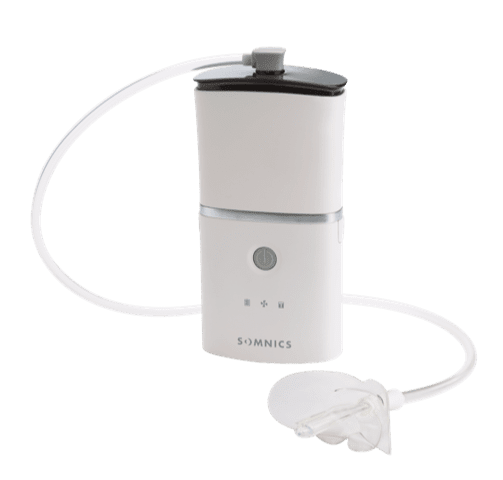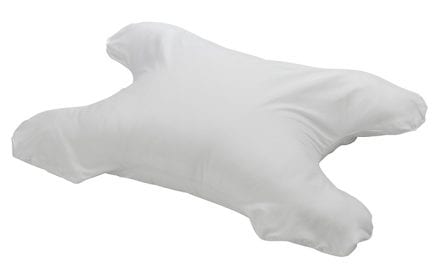A new generation of negative pressure therapies—which can be delivered orally or by neck collar—boast improvements over Winx.
By Lindsey Nolen
Ever since the Philips CPAP recall and subsequent CPAP shortage began, there’s been a push to identify alternative therapies for newly diagnosed obstructive sleep apnea (OSA) patients. One alternative is negative pressure therapies.
Unlike CPAP, which delivers pressurized air through a mask to stabilize the airway during sleep, negative pressure therapy uses subatmospheric (negative) and atmospheric (zero) pressures around the thorax and the abdomen. Negative pressure inside the thorax then stimulates spontaneous inspiration, pushing air into the lungs.
The sleep medicine community likely remembers the first renditions of negative pressure therapies for OSA from ApniCure’s Winx Sleep Therapy System, an oral pressure system that received US Food and Drug Administration (FDA) clearance in 2012 but has seemingly been unavailable since about 2017. Now, with the introduction of a new generation of negative pressure therapies, this treatment modality deserves a fresh evaluation. Delivered orally or by neck collar, the newest negative pressure therapies have several improvements over previous generations.
One company that is developing a negative pressure therapy for OSA is Sommetrics. Its aerSleep II device, which recently received FDA breakthrough designation, uses a flexible silicone rubber neck collar with a lightweight air pump to apply negative external pressure on the outside of the neck to open the airway.
“What we do is, from a physiologic point of view, similar to what CPAP does. We hold the airway open by changing the pressure gradient across the airway. CPAP does that by pushing air in, and negative pressure does that by pulling from the outside,” says Richard Rose, MD, co-founder, board chair, CEO, and chief medical officer of Sommetrics Inc, which is developing the aerSleep II continuous negative external pressure (cNEP) therapy. “The big unmet need here is developing a noninvasive treatment that’s comfortable and that people can wear night-after-night and get benefit from.”
Unlike CPAP, aerSleep does not impact the upper airway (nose or mouth), so the device has no need for humidification, Rose says, adding that this also means the device cannot aerosolize bacteria and viruses.
A pilot study found that cNEP appeared to be safe and effective during short-term use in subjects with OSA. Published in The Journal of Clinical Sleep Medicine, the study oversaw 15 subjects of which 13 (87%) were responders to cNEP: 9 had an excellent response (AHI < 5) and 4 had a partial response (AHI < 15 and < 50% baseline). It is currently being evaluated in a multi-center pivotal trial (SUPRA or “Study using negative pressure to reduce apnea”), which has been planned in conjunction with the FDA and is intended to provide the clinical basis for clearance to market in the United States.
“It is not a panacea, but it’s a good fit for the marketplace and will benefit a lot of people,” Rose says. “We have spent a lot of time and money perfecting this product, making it comfortable.”

Another medical device company, Somnics Health, has also revealed a negative pressure therapy for OSA recently. Somnics Health Inc received FDA clearance in May 2022 for iNAP Sleep, an oral negative pressure therapy.
iNAP allows patients to breathe through their nose naturally without blowing air into the body. It has a flexible oral interface with thermal-memory material that pulls the tongue forward to keep the airway open.
“Negative pressure therapies, like iNAP, are convenient and patient-centric,” says Olivier Lauzeral, Somnics Health general manager. “The soft tissue, such as the tongue and soft palate, will be pulled forward and upward towards the front teeth and the hard palate.” This naturally opens the upper airway (base of the tongue and soft palate) and allows the patient to breathe naturally and unobstructed through the nose. But if the occlusion occurs deeper in the throat, iNAP will have less effect than CPAP.
Though similar to Winx in some aspects such as appearance, iNAP takes “a very different path,” Lauzeral says. Most significantly, the negative pressure employed by iNAP is intermittent, not continuous. Once adequate negative pressure is reached, the pump stops. Sensors monitor the pressure and reactivate the pump only as needed.
With Winx, pumping was continuous and the device needed to be plugged into an electric outlet. iNAP, on the other hand, is battery-operated and can be used up to six nights on a single charge, according to Lauzeral.
iNAP also collects any excess saliva in “drypads” or highly absorbing packets that are disposed of every morning after use. “Winx was complicated to clean and maintain, and patients did not like dealing with their own saliva,” Lauzeral says.
The interface is also different. Winx’s oral interface was semi-rigid and patients selected from more than 10 sizes, according to Lauzeral. But iNAP’s is soft and one size fits almost all mouth sizes.
iNAP also boasts a smaller, thinner tube (3 feet versus Winx’s 6 feet) and has a companion phone app for the patient and a cloud-based platform for the physician.
“Winx was a great first attempt at negative oral pressure therapy for OSA patients to reach the market. iNAP brings an enhanced approach, based on the similar principles,” Lauzeral says.
For a patient to successfully use iNAP, s/he should be a nasal breather (since the mouth will be sealed). So far, the patient population who most appreciate using iNAP tend to be people who love to travel, be active, and so welcome the convenience of a light, portable, battery-operated therapy device, according to Lauzeral.
Joshua Lennon, MD, director of sleep medicine at Neurology Clinic PC in Tennessee and an assistant professor in the department of neurology at The University of Tennessee Health Science Center, says his patients have expressed that they love the simplicity of iNAP, its portability, and their improved sleep. Those who have tried positive airway pressure therapy in the past appreciate how comparatively smaller the negative pressure interface is.
“I prescribe iNAP for patients with OSA (minimal central sleep apnea) and who are able to comfortably breathe through their noses,” Lennon says. “The device is incredibly simple to operate, cordless, and easy to travel with, [requires] minimal maintenance, [and is] shockingly quiet. But most importantly, it is highly effective at improving airway patency to treat all severity levels of OSA.”
Lennon says that best practices for negative pressure settings and patient selection still need to be worked out. But he also sees “great opportunities for improved user and provider interfaces— software improvements and the user experience are likely coming before any major hardware or algorithm changes….Similar to the evolution of mobile phones, I expect a more compact hardware design with improved battery life. I am most excited about the possibility of adjustable pressures and the ability to respond on-the-go to changes in airway obstruction analogous to auto-adjusting CPAP.”
Lindsey Nolen is a Jacksonville, Fla-based journalist who has been writing about healthcare for over 6 years.
Reference
1. Kram JA, Woidtke RV, Klein KB, Rose RM. Evaluation of continuous negative external pressure (cNEP) for the treatment of obstructive sleep apnea: a pilot study. J Clin Sleep Med. 2017 Aug 15;13(8):1009-12.
Illustration 135537310 © Kharlamova | Dreamstime.com




